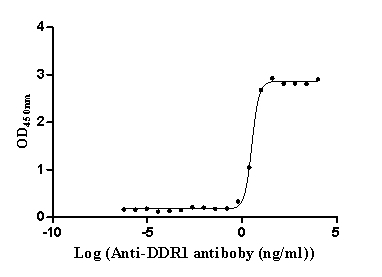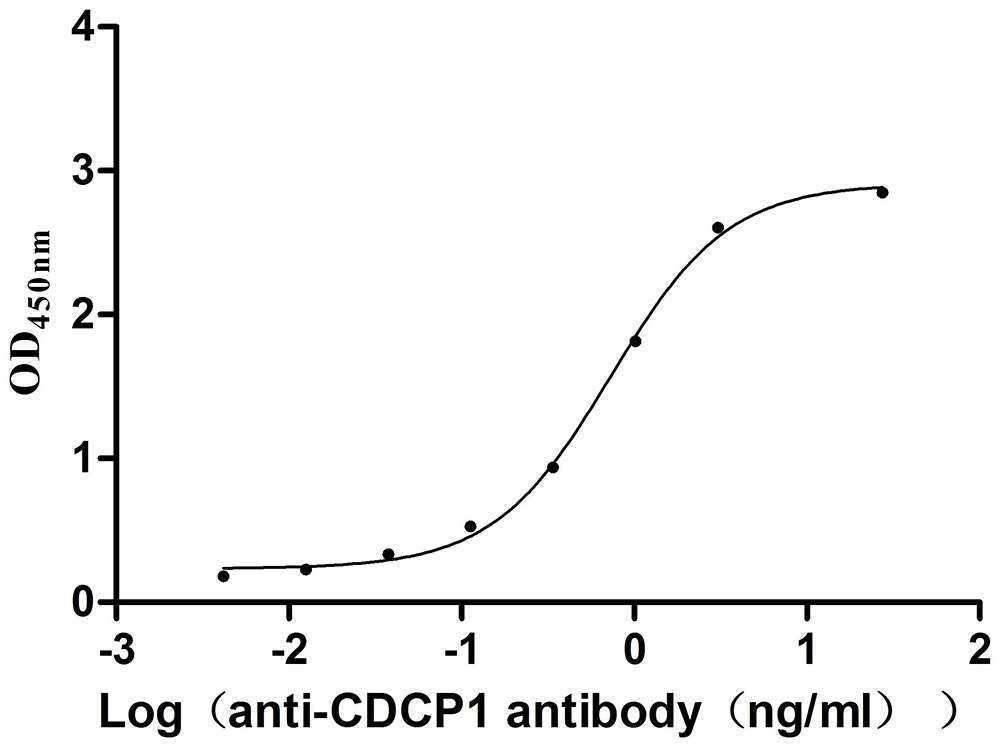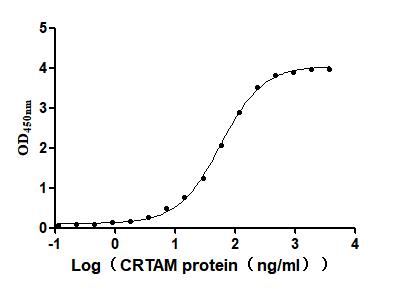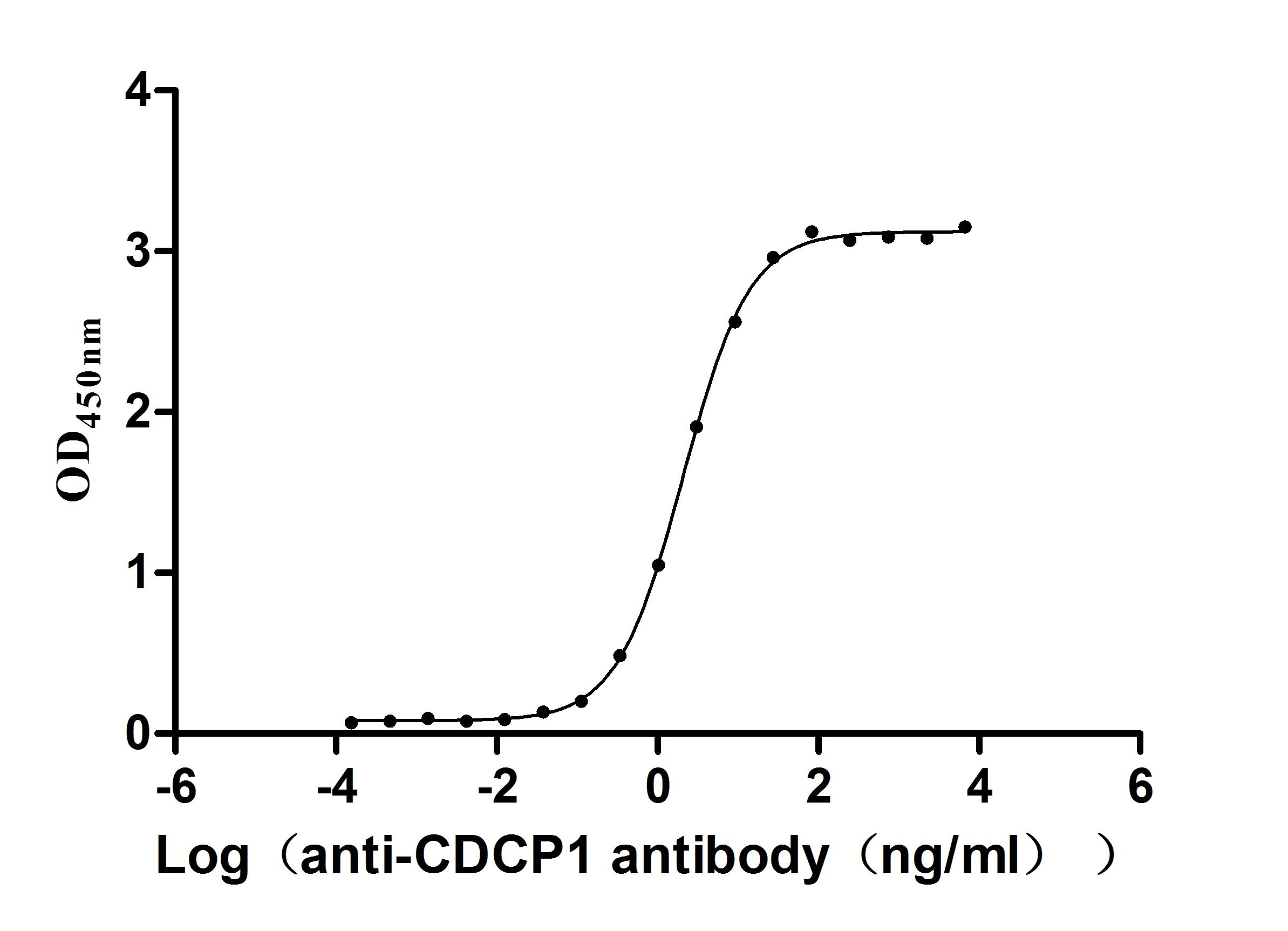Recombinant Human Caspase-4 (CASP4), partial
-
中文名稱:Recombinant Human Caspase-4(CASP4) ,partial,Yeast
-
貨號(hào):CSB-YP004549HU
-
規(guī)格:
-
來(lái)源:Yeast
-
其他:
-
中文名稱:Recombinant Human Caspase-4(CASP4) ,partial,Yeast
-
貨號(hào):CSB-EP004549HU
-
規(guī)格:
-
來(lái)源:E.coli
-
其他:
-
中文名稱:Recombinant Human Caspase-4(CASP4) ,partial,Yeast
-
貨號(hào):CSB-EP004549HU-B
-
規(guī)格:
-
來(lái)源:E.coli
-
共軛:Avi-tag Biotinylated
E. coli biotin ligase (BirA) is highly specific in covalently attaching biotin to the 15 amino acid AviTag peptide. This recombinant protein was biotinylated in vivo by AviTag-BirA technology, which method is BriA catalyzes amide linkage between the biotin and the specific lysine of the AviTag.
-
其他:
-
中文名稱:Recombinant Human Caspase-4(CASP4) ,partial,Yeast
-
貨號(hào):CSB-BP004549HU
-
規(guī)格:
-
來(lái)源:Baculovirus
-
其他:
-
中文名稱:Recombinant Human Caspase-4(CASP4) ,partial,Yeast
-
貨號(hào):CSB-MP004549HU
-
規(guī)格:
-
來(lái)源:Mammalian cell
-
其他:
產(chǎn)品詳情
-
純度:>85% (SDS-PAGE)
-
基因名:
-
Uniprot No.:
-
別名:Apoptotic cysteine protease Mih1/TX; CASP-4; CASP4; CASP4_HUMAN; Caspase 4 apoptosis related cysteine peptidase; Caspase-4 subunit 2; Caspase4; ICE(rel)-II; ICE(rel)II; ICEREL II; ICH2; Mih1/TX; Protease ICH-2; Protease TX; TX
-
種屬:Homo sapiens (Human)
-
蛋白長(zhǎng)度:partial
-
表達(dá)區(qū)域:-
-
蛋白標(biāo)簽:Tag?type?will?be?determined?during?the?manufacturing?process.
The tag type will be determined during production process. If you have specified tag type, please tell us and we will develop the specified tag preferentially. -
產(chǎn)品提供形式:Lyophilized powder
Note: We will preferentially ship the format that we have in stock, however, if you have any special requirement for the format, please remark your requirement when placing the order, we will prepare according to your demand. -
復(fù)溶:We recommend that this vial be briefly centrifuged prior to opening to bring the contents to the bottom. Please reconstitute protein in deionized sterile water to a concentration of 0.1-1.0 mg/mL.We recommend to add 5-50% of glycerol (final concentration) and aliquot for long-term storage at -20℃/-80℃. Our default final concentration of glycerol is 50%. Customers could use it as reference.
-
儲(chǔ)存條件:Store at -20°C/-80°C upon receipt, aliquoting is necessary for mutiple use. Avoid repeated freeze-thaw cycles.
-
保質(zhì)期:The shelf life is related to many factors, storage state, buffer ingredients, storage temperature and the stability of the protein itself.
Generally, the shelf life of liquid form is 6 months at -20°C/-80°C. The shelf life of lyophilized form is 12 months at -20°C/-80°C. -
貨期:Delivery time may differ from different purchasing way or location, please kindly consult your local distributors for specific delivery time.Note: All of our proteins are default shipped with normal blue ice packs, if you request to ship with dry ice, please communicate with us in advance and extra fees will be charged.
-
注意事項(xiàng):Repeated freezing and thawing is not recommended. Store working aliquots at 4°C for up to one week.
-
Datasheet :Please contact us to get it.
相關(guān)產(chǎn)品
靶點(diǎn)詳情
-
功能:Inflammatory caspase that acts as an essential effector of NLRP3 inflammasome-dependent CASP1 activation and IL1B and IL18 secretion in response to non-canonical activators, such as UVB radiation, cholera enterotoxin subunit B and cytosolic LPS. Thiol protease that cleaves a tetrapeptide after an Asp residue at position P1. Independently of NLRP3 inflammasome and CASP1, promotes pyroptosis, through GSDMD cleavage and activation, followed by IL1A, IL18 and HMGB1 release in response to non-canonical inflammasome activators. Plays a crucial role in the restriction of Salmonella typhimurium replication in colonic epithelial cells during infection: in later stages of the infection, LPS from cytosolic Salmonella triggers CASP4 activation, which catalyzes cleavage of GSDMD, resulting in pyroptosis of infected cells and their extrusion into the gut lumen, as well as in IL18 secretion. Cleavage of GSDMD is not strictly dependent on the consensus cleavage site but depends on an exosite interface on CASP4 that recognizes and binds the Gasdermin-D, C-terminal (GSDMD-CT) part. Pyroptosis limits bacterial replication, while cytokine secretion promotes the recruitment and activation of immune cells and triggers mucosal inflammation. Involved in LPS-induced IL6 secretion; this activity may not require caspase enzymatic activity. Involved in cell death induced by endoplasmic reticulum stress and by treatment with cytotoxic APP peptides found Alzheimer's patient brains. Activated by direct binding to LPS without the need of an upstream sensor. Does not directly process IL1B. During non-canonical inflammasome activation, cuts CGAS and may play a role in the regulation of antiviral innate immune activation.
-
基因功能參考文獻(xiàn):
- Results implicate pyroptosis induced by the CASP11/4-GSDMD pathway in the pathogenesis of alcoholic hepatitis PMID: 29108122
- Results indicate functional differences between human caspase-4 and murine caspase-11. PMID: 29339744
- The last four amino acids of the NleF carboxy terminus are essential in inhibiting caspase-4-dependent inflammatory cell death. PMID: 28593173
- Pathophysiological studies showed that the overexpression of the CASP4 gene was involved in the loss of proximal tubules and renal injury in nephropathic cystinosis patients. Considering kidney's key roles in sodium filtration and reabsorption CASP4 genes are involved in Blood Pressure regulation. PMID: 27271309
- We propose that microglial caspase-4 expression contributes to the cognitive impairments in Alzheimer's disease (AD), and that further study of caspase-4 will enhance our understanding of AD pathogenesis and may lead to novel therapeutic targets in AD. PMID: 27516385
- this study shows that activation of caspase-4 is mediated by interactions with endotoxin-rich membrane interfaces rather than by endotoxin monomers PMID: 28409545
- apoptosis is induced by rhein traditional Chinese medicine via induction of endoplasmic reticulum stress, caspase-4 and intracellular calcium in primary human hepatic HL-7702 cells PMID: 27003256
- Caspase-4 and caspase-5 mediate IL-1alpha and IL-1beta release from human monocytes after lipopolysaccharides stimulation. PMID: 26508369
- both caspase-4 and caspase-5 are functionally important for appropriate responses to intracellular Gram-negative bacteria. PMID: 26173988
- caspase-4 activation alone is sufficient to induce pyroptosis, this process depends on the NLRP3 inflammasome activation to drive IL-1beta maturation. PMID: 26174085
- This study reveled that CASP4 having a central role in the bipolar disease and schizophrenia manifestation. PMID: 25487697
- NF-kappaB can mediate Fas-induced apoptosis through caspase-4 protease PMID: 25695505
- implicate caspase-4 as a critical regulator of noncanonical inflammasome activation that initiates defense against bacterial pathogens in primary macrophages PMID: 25964352
- this study has identified epithelial-expressed caspases-4 and -5 as biomarkers with diagnostic and therapeutic potential in colorectal cancer. PMID: 25943872
- Authors observed increases in the endoplasmic reticulum stress markers BiP and cleaved caspase-4 in Duchenne muscular dystrophy patient biopsies, compared with controls. PMID: 24879640
- The caspase-4/11 inflammasome also governs activation of the proinflammatory cytokine, interleukin (IL)-18, in response to intracellular and extracellular enteric pathogens. PMID: 25121752
- function of caspase-4/5/11 represents a new mode of pattern recognition in immunity and also an unprecedented means of caspase activation PMID: 25119034
- caspase-4 can support activation of caspase-1 and secretion of IL-1beta and IL-18 in response to priming signals (LPS or Pam3CSK4) alon PMID: 24879791
- TLR3 stimulation in keratinocytes induces a caspase-4 dependent release of pro-IL-1beta, but further processing to active IL-1beta is limited. Furthermore, TLR3 stimulation results in pyroptotic- and apoptotic cell death. PMID: 23845419
- Shigella OspC3 interacts with the caspase-4-p19 subunit and inhibits its activation by preventing caspase-4-p19 and caspase-4-p10 heterodimerization. PMID: 23684308
- TMEM214 is essential for endoplasmic reticulum (ER) stress-induced apoptosis by acting as an anchor for recruitment of procaspase 4 to the ER and its subsequent activation. PMID: 23661706
- Loss of heterozygosity contributes to tumor progression of oral squamous cell carcinoma, and a specific role for PDCD4, CTNNB1, and CASP4 was found. PMID: 21781452
- These experiments identify caspase 4 as a novel regulator of TNF-alpha-induced NF-kappaB signaling that is required for the activation of I-kappaB kinase. PMID: 22733992
- Caspase-4 expression is essential for efficient nucleotide-binding domain leucine-rich repeat containing, Pyrin domain containing-3 and for absent in melanoma 2 inflammasome-dependent proIL-1beta activation in macrophages PMID: 22246630
- Levels of c-Rel directly modulated expression of caspase-4 as well as other endoplasmic reticulum stress genes. PMID: 21984918
- Data suggest that Casp4, Casp 6 and TNFSF10 are differentially expressed in potentially fertile and subfertile men and represent useful biomarkers for predicting male fertility in combination with P1 and P2. PMID: 21317160
- results suggest that caspase-4 directly activates caspase-9 by the processing of procaspase-9 at Asp-315 in endoplasmic reticulum stress-induced neuronal apoptosis PMID: 21282934
- Neuronal cell death is induced via cleavage of caspase-4 in endoplasmic reticulum cells under stress in vitro. PMID: 20816908
- This study suggests a possible role of caspase-4 in the apoptotic loss of proximal tubular cells. PMID: 19705160
- results show that activation of caspase-4 contributes to TRAIL-induced apoptosis and is associated with induction of ER stress by TRAIL in melanoma cells PMID: 20514521
- Caspase-4 can function as an ER stress-specific caspase in humans, and may be involved in pathogenesis of Alzheimer's disease. PMID: 15123740
- caspase-12 and caspase-4 are not required for the induction of ER stress-induced apoptosis and that caspase-4-like activity is not always associated with an initiating event. PMID: 15975932
- the familial Alzheimer's disease-linked presenilin 1 mutation accelerates the cleavage of caspase-4 under the endoplasmic reticulum stress PMID: 17942194
- These results demonstrate that induction of GADD153/CHOP plays a pivotal role in mechanism of ER stress-induced cell death in SH-SY5Y cells, on the other hand, cleavage of pro-caspase-4 by activation of calpain play a crucial role in SK-N-SH cells. PMID: 18029041
- TRAF6-caspase-4 interaction, triggered by LPS, leads to NF-kappaB-dependent transcriptional up-regulation and secretion of important cytokines and chemokines in innate immune signaling in human monocytic cells. PMID: 18056395
- somatic mutation of the CASP4 gene is common in gastrointestinal stromal tumor & suggest a possibility that CASP4 mutation might lead to alteration of apoptotic or inflammatory function & contribute to pathogenesis of some gastrointestinal stromal tumors PMID: 19269008
顯示更多
收起更多
-
亞細(xì)胞定位:Cytoplasm, cytosol. Endoplasmic reticulum membrane; Peripheral membrane protein; Cytoplasmic side. Mitochondrion. Inflammasome. Secreted.
-
蛋白家族:Peptidase C14A family
-
組織特異性:Widely expressed, including in keratinocytes and colonic and small intestinal epithelial cells (at protein level). Not detected in brain.
-
數(shù)據(jù)庫(kù)鏈接:
Most popular with customers
-
Recombinant Human Epithelial discoidin domain-containing receptor 1 (DDR1), partial (Active)
Express system: Mammalian cell
Species: Homo sapiens (Human)
-
Recombinant Mouse CUB domain-containing protein 1 (Cdcp1), partial (Active)
Express system: Mammalian cell
Species: Mus musculus (Mouse)
-
Recombinant Human CD81 antigen (CD81), partial (Active)
Express system: Mammalian cell
Species: Homo sapiens (Human)
-
Recombinant Human Cytotoxic and regulatory T-cell molecule (CRTAM), partial (Active)
Express system: Mammalian cell
Species: Homo sapiens (Human)
-
Recombinant Mouse Cytotoxic and regulatory T-cell molecule (Crtam), partial (Active)
Express system: Mammalian cell
Species: Mus musculus (Mouse)
-
Recombinant Human Interleukin-2 (IL2) (Active)
Express system: Mammalian cell
Species: Homo sapiens (Human)
-
Recombinant Human Killer cell immunoglobulin-like receptor 3DL2 (KIR3DL2), partial (Active)
Express system: Mammalian cell
Species: Homo sapiens (Human)
-
Recombinant Macaca fascicularis CUB domain containing protein 1 (CDCP1), partial (Active)
Express system: Mammalian cell
Species: Macaca fascicularis (Crab-eating macaque) (Cynomolgus monkey)




















